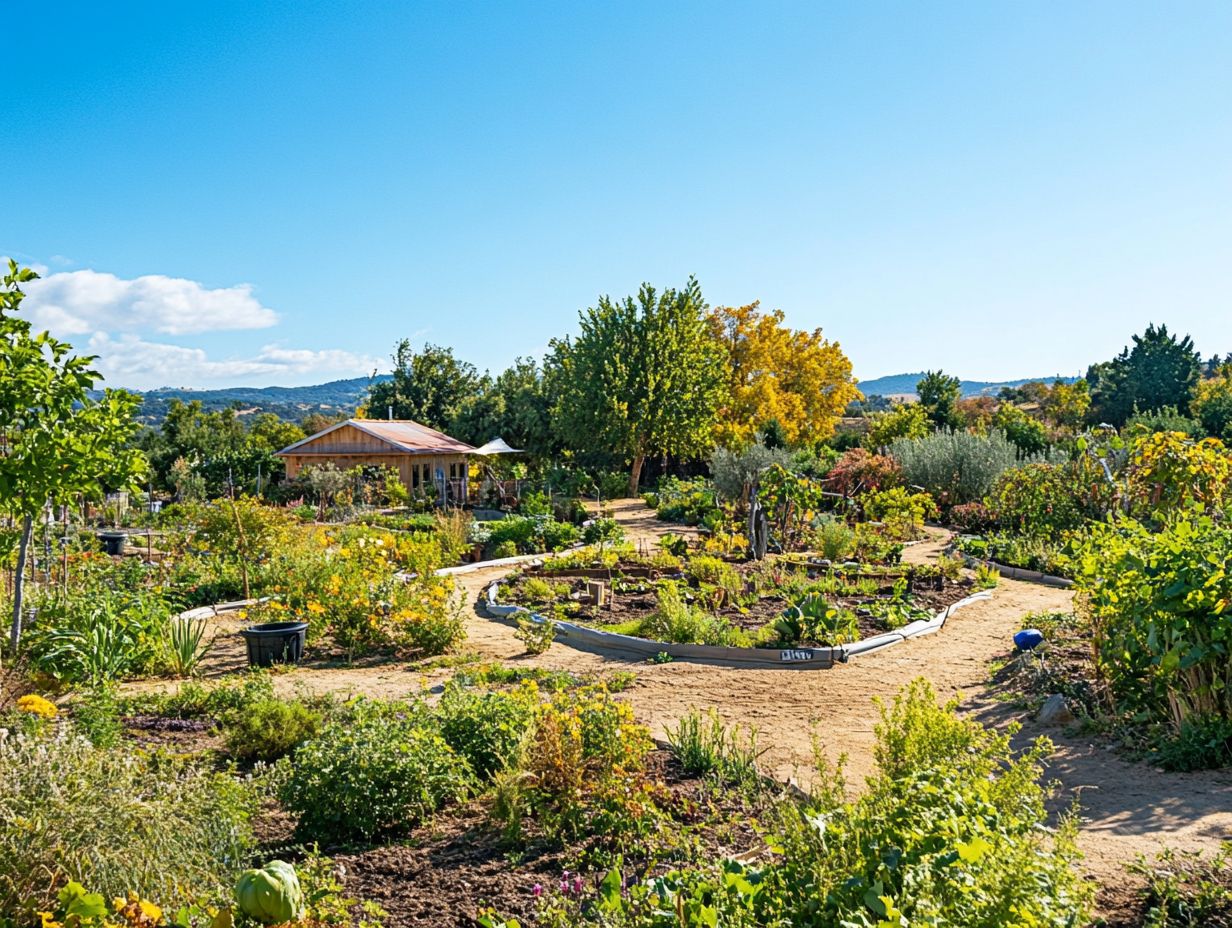Designing for Climate Resilience in Permaculture
Climate change presents formidable challenges, yet permaculture offers a sustainable avenue for progress.
This article delves into the concept of climate resilience within permaculture. It begins with essential definitions and advances through critical factors such as soil health, water management, and plant diversity.
You ll uncover practical design strategies to enhance resilience, supported by real-world applications and compelling case studies.
Gain insights on evaluating the effectiveness of these systems and making necessary adjustments to ensure continued success.
Join us now to unlock the secrets of how permaculture can thrive in our changing climate!
Contents
- Key Takeaways:
- Understanding Climate Resilience in Permaculture
- Factors Affecting Climate Resilience in Permaculture
- Designing for Climate Resilience
- Implementing Climate Resilience in Permaculture Systems
- Evaluating and Improving Climate Resilience
- Frequently Asked Questions
- What is permaculture design and why is it important for designing for climate resilience?
- How does climate change affect permaculture design?
- What are some key principles of designing for climate resilience in permaculture?
- How can permaculture design help mitigate the effects of climate change?
- What are some important considerations when designing for climate resilience in permaculture?
- How can I incorporate climate resilience into my own permaculture design?
Key Takeaways:

- Understand why climate resilience matters in permaculture systems and its impact on overall sustainability and productivity.
- Consider various factors such as soil health, water management, and microclimate when designing for climate resilience in permaculture.
- Implement strategies for adaptation and mitigation in permaculture systems to increase their resilience, and evaluate and improve upon them regularly.
Understanding Climate Resilience in Permaculture
Understanding climate resilience in permaculture is essential for cultivating sustainable agricultural practices. This approach can adeptly respond to climate change while enriching ecological systems and community capabilities, particularly when designing with perennials in permaculture.
By integrating permaculture design principles, you can establish systems that not only endure climate impacts but also promote ecological harmony and biodiversity. This approach underscores the significance of permaculture design: challenges and solutions in achieving lasting sustainability through local resources and indigenous knowledge.
It not only tackles the challenges presented by climate disturbances but also encourages community engagement and stewardship of the natural environment.
Defining Key Terms
Defining key terms related to climate resilience and permaculture is essential for your holistic understanding of how these concepts interconnect within ecological systems and agricultural practices.
Climate resilience refers to the capacity of communities and ecosystems to withstand and recover from the impacts of climate change, including extreme weather events and rising sea levels. Within this framework, permaculture design: the role of microclimates stands out as a sustainable agricultural practice that emulates natural ecosystems to cultivate productive landscapes.
This approach employs various adaptation strategies (tactics that enable systems to adjust to environmental changes) such as crop rotation and agroforestry (the practice of integrating trees and shrubs into crop and livestock systems).
For example, by utilizing diverse plant species, you enhance food security while promoting biodiversity, which in turn strengthens ecosystems against climate-related challenges. Grasping these terms is crucial for anyone looking to engage in meaningful environmental stewardship.
Factors Affecting Climate Resilience in Permaculture
Numerous factors play a crucial role in shaping climate resilience within permaculture. These elements directly influence how agricultural systems adapt to and recover from the impacts of climate change. Understanding permaculture design: assessing and adapting is essential for enhancing resilience and ensuring sustainable agricultural practices.
Soil Health and Plant Diversity
Soil health and plant diversity are essential elements of permaculture design. They significantly enhance biodiversity and nurture resilient ecological systems.
By adopting soil health practices like composting and cover cropping, you can greatly improve nutrient cycling (the process of optimizing nutrient availability in the soil) and soil structure. These practices enrich the soil and promote a diverse array of plant species, which work together harmoniously to create stable ecosystems.
The interactions among diverse plants can boost pest control and pollination, leading to a more sustainable agricultural landscape. These methods provide a proactive strategy for mitigating the impacts of climate change by sequestering carbon and reducing erosion, ultimately cultivating a more resilient environment for both farming and natural habitats.
Water Management

Effective water management is crucial for building climate resilience in permaculture. As precipitation patterns shift and climate variability intensifies, implementing techniques like rainwater harvesting and efficient irrigation strategies becomes essential.
Rainwater harvesting captures and stores runoff, providing a supplementary water source during dry spells. This is vital in arid regions.
Drip irrigation systems minimize water wastage by delivering moisture directly to plant roots. This boosts crop yields and promotes healthier soil ecosystems.
By adopting these methods, you ensure sustainable agricultural practices while positively impacting local ecological systems. You ll foster biodiversity and alleviate pressure on existing water resources.
Microclimate Considerations
Understanding microclimates is essential for enhancing climate resilience in permaculture. These localized environmental conditions impact temperature patterns and local ecological systems.
Microclimates create unique zones within a larger landscape, each with its own distinct temperature, humidity, and light levels. Recognizing these variations allows you to implement targeted strategies that cater to the specific needs of various plants and animals.
For instance, positioning windbreaks in exposed areas can protect certain crops. The shade from taller trees benefits understory plants that thrive in lower light conditions.
This thoughtful approach not only bolsters biodiversity but also enhances soil health, nurturing an ecosystem better equipped to withstand climate fluctuations.
Designing for Climate Resilience
Designing for climate resilience in permaculture means crafting systems that adapt to shifting environmental conditions. This approach embodies the principles of sustainability and incorporates the influence of climate on permaculture design, ensuring that we design with nature.
Create a harmonious balance where nature and human needs coexist. Ensure your efforts contribute positively to the ecosystem while preparing for future uncertainties.
Strategies for Adaptation and Mitigation
Implementing effective strategies for adaptation and mitigation is crucial for enhancing climate resilience within your permaculture practices. This approach promotes soil health and biodiversity while reducing dependency on external inputs.
Consider agroforestry, which involves planting trees alongside crops. This innovative practice boosts productivity and enhances ecosystem services. For example, a farm that embraced agroforestry saw improved yields and a significant reduction in erosion.
Another compelling strategy is the implementation of rainwater harvesting systems. These systems capture and store rainfall, allowing for more efficient water management during dry spells.
Integrating these strategies enables you to achieve not only environmental benefits but also economic gains. You ll help the environment while saving money and resources.
Implementing Climate Resilience in Permaculture Systems
To effectively implement climate resilience in permaculture systems, cultivate a comprehensive understanding of practical applications. Delve into real-world case studies that showcase successful strategies, including the role of design in climate adaptation.
Act now! Consult local experts and start planning your own systems to transform your landscape today.
Practical Applications and Case Studies

Practical applications and case studies are essential for illustrating how you can effectively integrate climate resilience into permaculture systems, showcasing successful and sustainable outcomes.
These real-world examples not only offer a blueprint for innovation but also illuminate various methods that can be customized to meet specific environmental and social contexts. By diving into various projects, you’ll discover the exciting methods used ranging from advanced water management techniques to innovative soil restoration practices and see their impacts on both the ecosystem and the communities involved.
Engaging local stakeholders often plays a pivotal role, cultivating a sense of ownership that further strengthens the resilience of these systems. These studies serve as inspirational benchmarks, demonstrating how resilient permaculture practices can flourish even in the face of challenges posed by climate change.
Evaluating and Improving Climate Resilience
Evaluating and enhancing climate resilience in permaculture is crucial for maintaining the effectiveness of these systems in adapting to climate change and addressing environmental challenges. Prioritizing this evaluation helps your permaculture practices thrive, and understanding permaculture design for sustainability can further support your efforts in the face of shifting climate conditions.
Assessing Success and Making Adjustments
Assessing your success and making adjustments in permaculture systems is essential for maintaining climate resilience and ensuring that your ecological design remains effective.
This process encompasses a range of evaluation techniques and metrics that help you determine how well your systems are performing amid changing environmental conditions. By leveraging key performance indicators (KPIs), which are measurable values that show how effectively a system is achieving its goals, you can track your progress over time and pinpoint areas that need improvement.
Adaptive management is crucial, encouraging you to stay flexible and responsive to new information, refining your approaches based on real-world outcomes.
Regularly assessing and adjusting not only boosts your permaculture practices but also strengthens your systems against future climatic challenges, ultimately cultivating a more sustainable relationship with the environment.
Frequently Asked Questions
What is permaculture design and why is it important for designing for climate resilience?
Permaculture is a design approach that mimics natural ecosystems to create sustainable and regenerative systems. It is crucial for designing for resilience in your garden because it focuses on creating self-sufficient and resilient systems that can withstand and adapt to changing environmental conditions.
How does climate change affect permaculture design?

Climate change has a significant impact on permaculture design as it brings about unpredictable weather patterns, extreme temperatures, and other environmental changes. These factors must be considered when designing for social permaculture to ensure the system can withstand and adapt to these changes.
What are some key principles of designing for climate resilience in permaculture?
- Diversity
- Redundancy
- Integration
Some key principles include diversity, redundancy, and integration. Diversity ensures that the system has a variety of elements that can perform different functions and provide resilience in case of failure. Redundancy means having multiple elements that perform the same function, providing a backup in case of failure. Integration involves connecting different elements in the system to create a self-sustaining and resilient whole.
How can permaculture design help mitigate the effects of climate change?
Permaculture design can help mitigate the effects of climate change by promoting sustainable and regenerative practices, such as using renewable energy sources, conserving water, and reducing waste. These practices can help reduce the carbon footprint and contribute to a healthier environment.
What are some important considerations when designing for climate resilience in permaculture?
Consider the local climate and how it may change over time. Assess the needs and limitations of your site, and include a variety of plants and animals to boost resilience.
Engaging and educating the community is essential for the long-term success of your permaculture design. Their involvement will help ensure sustainability.
How can I incorporate climate resilience into my own permaculture design?
Start by researching your local climate. Choose plants and animals that can withstand potential changes.
Incorporate systems like water catchment to collect rainwater. Use windbreaks, which are rows of trees or shrubs, to protect your plants from strong winds.
Regularly monitor your design and adjust as needed. This will help maintain resilience against changing environmental conditions.






